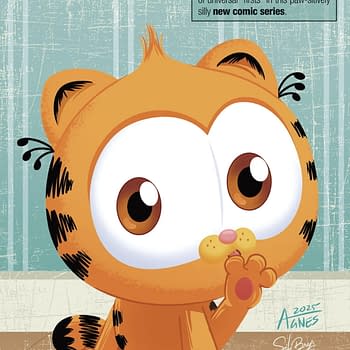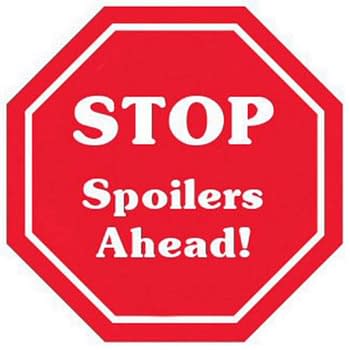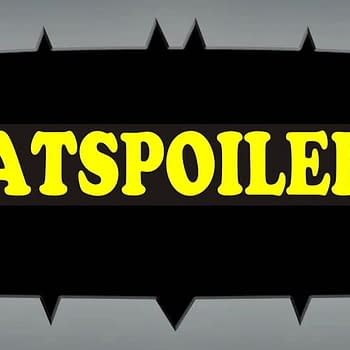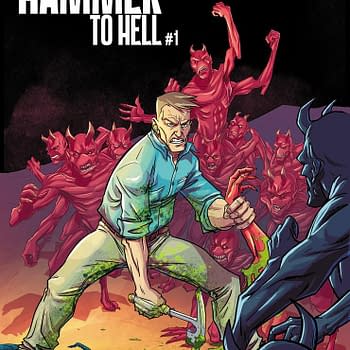Posted in: Comics | Tagged: anthony del col, Comics, conor mccreery, dynamite, entertainment, Sherlock Holmes vs Harry Houdini
Writer's Commentary – Sherlock Holmes Vs. Harry Houdini
Normally we get a Writers' Commentary for a single issue. Today we have the commentary for all five issues of Sherlock Holmes Vs Harry Houdini by Anthony Del Col (A) & Conor McCreery (C). Cover art by John Cassaday (issue 1) and Aaron Campbell (issue 2-5).
The Backstory
A: We were approached by Dynamite's Nick Barucci early last year, stating that he had an idea kicking around that he thought Conor and I would be perfect to create. We got on the phone with him and I remember him saying "I'd like to put Sherlock Holmes and Harry Houdini in the same world together" and I remember getting excited as soon as he mentioned Sherlock Holmes. He's a character that I've always enjoyed and had just started watching the BBC Steven Moffat (and Mark Gatiss) version so it seemed like perfect artistic timing.
C: Nick had been someone we had had a long conversation with about Kill Shakespeare when we first started out. We had always really respected he and (Dynamite COO) Juan Collado (and the rest of the Dynamite team) so when they came to us and said we were their first choice and we had free run to pitch them that was pretty exciting. IDW has been great to work with, but it's always intriguing to see how the game works at other publishers.
A: In real-life Houdini and Holmes author Sir Arthur Conan Doyle had been good friends but were torn apart over the subject of spiritualism (Doyle believed in it, Houdini was a steadfast opponent). So we knew that this would have to serve as the core of our story. We had put together one original pitch that we really liked (and it could show up in a future series…) but Dynamite Editor Joe Rybandt worked with us on refining it into the story you see today, helping us with developing it for new readers. (I would also be remiss to not mention Molly Mahan, who served as our day-to-day editor on the series once we were on the same page as Joe.)
C: The Dynamite team is spectacular when it comes to supporting writers. We were given a lot of support, but also a lot of freedom. They even put up with our odd-ball perfectionist streak – we'll often do three or four edits of the comic after the first lettering draft trying to get the page to be JUST right (Although Joe DID send us one picture of him saluting us in a non-safe for work way… ).
A: First issues are always a lot of fun – and also very structured as we there is a list of things that have to be accomplished (introduce characters, inciting incident, etc.). This first issue only took about two days to write the first draft – perhaps the quickest of any of our issues. One of the things we really wanted to focus on the inherent comedy to be found putting these two larger-than-life (and the egos to match) together. For their first scene together we wanted to focus on having these two alpha males circle each other and try to establish that they are the bigger dog.
C: Anthony had taken the first crack at this issue and I remember being really pleased with the dialogue in the first scene between Holmes and Houdini – especially when Houdini asks Holmes if he's been charged with being: "a jackass". The best thing about co-writing is laughing your ass off when you read your partner's handiwork.
A: Conor really added to the issue in the Page 11 sequence that reveals the softer side of Houdini. In our research we realized that Bess Houdini had played such a crucial role in Harry's life and, in a story with so many strong male characters, we decided that this female wouldn't take guff from anyone – especially her husband.
C: Ah, you're making me blush… (hmmm, is that why I'm good at the softer stuff?)
Bess is a really fun character. Originally, we wanted to spend some more time with her and Watson – they could be a bit of a peanut gallery as they watch these two HYPER Type A personalities battle with each other. We didn't get to do much of that, but Bess still got a few digs in to both of our leads – if we do more in the series, we'd love to have a B story where we follow Bess and Watson on an adventure without those two loudmouths, Holmes and Houdini, getting in the way.
C: This was where we wanted to get a bit more into the mystery and broaden out Houdini's world, since of course he's the "real" person here. It was a lot of fun to dig into Houdini's life and to come up with possible rivals. Anthony was also a big fan of finding a way to bring in Houdini's cinematic experiences, so we explored that too – and realized that our time period, 1900, was a pretty intriguing time for the history of cinema.
Film was a motivator for the chase scene at the end. We wanted to find a way to nod to the classic film-noir chases – two men in the concrete jungle trying to outwit the other — and to show Holmes succeeding in Houdini's world (physical accomplishment) and Houdini in Holmes (out-thinking your opposition). We think the second-last scene really did that in a fun way.
A: The second issue of a series is always the toughest. The first issue establishes the characters and the world. The second issue builds upon that. What are the twists along the way – it's important to show your cards too early but you want to keep the reader involved. We liked incorporating some of Houdini's actual real-life peers as potential suspects in the murder here.
A: The middle issue of a story arc is so incredibly crucial and with this third issue it was key to have Holmes and Houdini continue to be at odds, and then actually learn to work together before realizing that even that's probably not enough.
My favourite scene is the one in which Houdini's wife Bess chides both her husband and Holmes for not working together. We wanted to capture the feeling of two kids who are being scolded by a parent or teacher and they want nothing more than to get out of there and not admit they were wrong. Here are two amazingly smart and perceptive characters yet they have been acting like children. I think we captured the humour nicely here.
C: The absolute best part of this issue to me is the work done by artist Carlos Furuzono to sell the strobe effect of our villain's second murder. Watching someone literally lose their head, from the angle he shot it, and with the colouring that Aikau (series colourist Aikau Oliva) chose was top notch comics. I also loved a couple of sneaky-funny moments in the issue – like Holmes telling the hypnotist to leave his own office, or Houdini trying to charge a pint to Holmes (while fleeing the bar).
A: We had originally conceived of Bess nearly-drowning in a magic trick gone awry (hence the amazing cover by Aaron Campbell but, as we sat down to script it, we found it too repetitive with what had happened in the first issue. We really wanted to focus on the cool "strobe effect" and see if that could be created in comics – and Carlos did a really good job with it.
C: This was a tricky one. We had a lot to try to accomplish in this issue, and sadly one of our favourite ideas had to be cut. We really wanted to get Mrs. Hudson in the story. She can be this greatly entertaining foil in the best stories, and we had what we thought was a very funny scene with her in it, that visually twinned Houdini's experience at the hospital, but we had to pull it out to focus on what was really important – Houdini's discovery that this conspiracy extends to the police, and of course Holmes' drug use.
A: When we were putting together who our Sherlock Holmes would be we realized that we really needed to give him a weakness – something other than his arrogance that was getting in the way of his cases. It's widely known that he had a drug problem, and despite thinking that it was a great way to make him a fully-fleshed character, I had been disappointed that it hadn't really been explored in great details in the original books. This story allowed us the opportunity to delve into it further.
C: Of course at the time drugs like cocaine and opium were in common usage, so we needed to get Holmes to interact with something that would feel exotic and dangerous.
But Holmes isn't some random thrill seeker – he has a reason for everything he does, Ayahuasca has a long history of being used in Peru's indigenous culture as a medicine to help people face their hidden fears. Because Holmes puts so much pressure on himself to "get it right", we felt that was the deeper issue – his perceived failures of the past, and the worry that maybe he was slowing down because of age.
It was important to us to ground Holmes' reasons for turning to drugs in the canon and The Case of the Dancing Men is one of only two Holmes' stories (that we're aware of) where Holmes fails his client and doesn't stop the crime. When we learned about that story, and especially the visual elements of it, we knew it had to fit in our tale. In fact, sharp eyed readers will notice that in the trade we ret-con'ed a scene in issue 2 in order to further seed the Dancing Men mythos.
A: It took Conor and I quite a while to figure out where to set this final scene as we wanted to make the London spot very realistic and tie it into the city. Not being in London we had to do a lot of research on different areas in the city and their histories. We had the rough outline of what the major plot points and motivations were and then reverse-engineered the geography to fit it all in.
It was important for our villain to do something that seemed quite magical and would stump both Holmes and Houdini, and when we discovered the Crimean War Memorial it all came together in one fell swoop.
C: Yeah, we spent several meetings on Google Maps, tooling around London trying to find a spectacular location that also held some story significance. We rejected the Thames, the Tower of London, Westminster Abbey, a whole whack of great locales (we even thought about using the Globe Theatre as an in-joke for Kill Shakespeare fans before dismissing that idea). In the end though the Crimean War Memorial made the most sense because of how it figured into the Russian element of the story. The Brits made the trophy out of the cannons they seized in the battle – we knew that would be the sort of thing to tweak our villain's sense of pride.
The next tough thing though was figuring out how to make the clue that Houdini gets in issue #4 work. It was a good thing that we were pretty far ahead of deadline at this point.
A: It was important to have the two main characters really learn from each other in this story, and to use these learnings to battle our big bad. It was tough to figure out a way to get the two separate but we were able to come up with a fun and dramatic way.
C: It's one of the parts of standard story structure that I find the most problematic – you want the satisfaction of seeing your heroes disagree and then come together, but how do you do it without it feeling like it's: "oh, of course they fought, and of course they're going to get back together."
Thankfully Houdini and Holmes's similar personalities created a great opportunity for them to clash, but underneath it the two men both LOVE learning new things. It felt natural that they would both gravitate back to the other, if only to see what they would discover – of course Bess' kidnapping and an impending terrorist attack didn't hurt either.
For more on Sherlock Holmes Vs. Harry Houdini, click here.



















